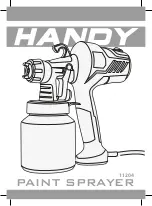
7
PREPARATION TIPS
• Always stir and strain the material thoroughly before use.
• With any spraying job you should always ensure that you have properly prepared the surface to get the best finish.
That is, all surfaces are free from dust, dirt, rust and grease. Lightly pressure wash decks or exterior surfaces and
ensure that they are dry before spraying.
• Even though HVLP sprayers have very little overspray, it is recommended that you mask all edges and other areas
and use drop cloths to protect your floors and anything else in the spraying area that you wish to remain untouched.
• Skin that forms on the top of paint can clog the sprayer. Remove skin before mixing. Strain with a funnel with a filter
attached or through hosiery to remove any impurities that could clog system.
• Before starting have gloves, paper towels, rags etc. available for unex-
pected spills.
FILLING THE CANISTER - (FIGURE D)
• Check to make sure that the canister is completely screwed onto the
sprayer.
• Lay the sprayer on its side with the canister side lid facing up.
• Unscrew the lid on the side of the canister.
• Pour the properly thinned and strained material to be sprayed into the
side fill canister (
figure D
).
TIP: Use the mixing bucket provided to
pour material from the original material container into the side fill
canister.
• Clean any residual liquid from the threads or sides of the canister and
sprayer.
• Starting the threads evenly, screw the lid completely onto the side fill
canister. Check the lid to make sure it is threaded on squarely and
completely before picking up the sprayer.
OPERATION
MATERIAL FLOW ADJUSTMENT
Set the material volume by turning the
material adjustment knob on the trigger of the
sprayer.
• For maximum material flow, thread knob all
the way in as shown in
figure E
.
• For minimum material flow, thread knob all
the way out as shown in
figure E1
.
The flow indicator on the side of the sprayer
moves forward (minimal liquid flow) and
backward (maximum liquid flow) as the trigger
is depressed.
TIP: Always test the spray pattern on scrap cardboard or similar material first. Begin with the material
adjustment knob on the highest flow setting (threaded all the way in). If less flow is desired, dial the material
adjustment knob out. Heavier, thicker materials should be sprayed with the knob dialed farther in. Thinner
materials should be sprayed with the knob dialed farther out.
THINNING TABLE
SPRAY MATERIAL
RUNOUT TIME
Clear and semi-transparent stains and sealers
No thinning required
Oil based primers, varnishes and polyurethane
(Less than 2 minute runout)
Solid color water based stains
May require thinning
Water based or latex paints
(More than 2 minute runout)
Note: Not recommended for textured paint
E
E1
D
Содержание SmartSelect BDPH200
Страница 39: ...39 ...
Страница 40: ...Cat No BDPH200 Form No 90572159 JUNE 2011 Copyright 2011 Black Decker Printed in China 40 ...








































